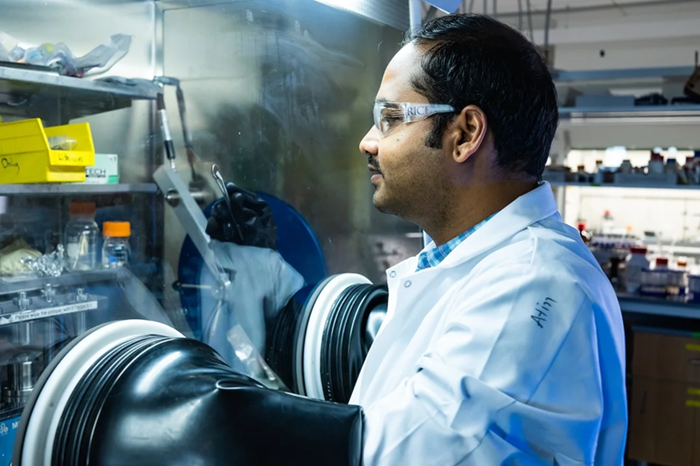Researchers from Rice University's Department of Materials Science and NanoEngineering, in partnership with Baylor University and the Indian Institute of Science Education and Research Thiruvananthapuram, have presented a novel solution in a recent study that may have an impact on electrochemical energy storage technologies. The Advanced Functional Materials journal published the study.
 Atin Pramanik, a postdoctoral associate in Ajayan’s lab, examines the battery prototype. Image Credit: Jeff Fitlow/Rice University
Atin Pramanik, a postdoctoral associate in Ajayan’s lab, examines the battery prototype. Image Credit: Jeff Fitlow/Rice University
The need for sustainable and reasonably priced battery technologies is growing along with the global demand for electric vehicles and renewable energy storage.
The team worked with specially shaped carbon materials with a pure graphitic structure, such as tiny cones and discs, using a byproduct of the oil and gas industry.
A long-standing problem for anodes in battery research may be solved by these unconventional forms created by scalable pyrolysis of hydrocarbons: how to store energy using elements like sodium and potassium, which are far more accessible and less expensive than lithium.
For years, we have known that sodium and potassium are attractive alternatives to lithium, but the challenge has always been finding carbon-based anode materials that can store these larger ions efficiently.
Pulickel Ajayan, the Benjamin M. and Mary Greenwood Anderson Professor and Study Corresponding Author, Rice University
Breaking the Graphite Barrier
Graphite is used as the anode material in conventional lithium-ion batteries, but the same graphite structure breaks down when it comes to potassium or sodium. They cannot move in and out of the densely packed layers of graphite because their atoms are just too large and their interactions are too complicated.
However, the team discovered a solution by reconsidering the microscopic structure of carbon. The curvature and spacing provided by the cone and disc structures allow sodium and potassium ions to enter without the need for artificial modifications such as chemical doping, which is the deliberate addition of trace amounts of particular atoms or molecules to alter their properties.
We were surprised to see just how well these pure, curved graphitic structures performed. Even without heteroatoms, they allowed for reversible intercalation of sodium ions and did so with minimal structural stress.
Atin Pramanik, Study First Author and Postdoctoral Associate, Rice University
Durable, Scalable, and Green
The carbon cones and discs could store approximately 230 milliamp-hours of charge per gram (mAh/g) in lab tests using sodium ions. Even after 2,000 fast charging cycles, they could still hold 151 mAh/g. Although the performance was not quite as good as with sodium batteries, they also functioned well with potassium-ion batteries.
Cutting-edge imaging methods such as solid-state nuclear magnetic resonance and cryogenic transmission electron microscopy verified that the material maintained its shape over thousands of charge-discharge cycles and that ions were entering and leaving the carbon structure as predicted.
Pramanik said, “This is one of the first clear demonstrations of sodium-ion intercalation in pure graphitic materials with such stability. It challenges the belief that pure graphite cannot work with sodium.”
The ramifications are extensive. This lessens dependency on lithium, which is getting more costly and difficult to source geopolitically, and opens the door for more reasonably priced sodium-ion batteries.
Additionally, cone/disc carbon offers a more environmentally friendly method of producing battery anodes because it can be made from waste materials from the oil and gas sector.
A Turning Point for Battery Design
The new study represents a change in approach, prioritizing morphology over chemical modification, whereas the majority of previous research in this field has concentrated on hard carbons or doped materials.
Ajayan said, “We believe this discovery opens up a new design space for battery anodes. Instead of changing the chemistry, we are changing the shape, and that is proving to be just as interesting.”
We are not just developing a better battery material. We are offering a real pathway to energy storage that is cleaner, cheaper, and more widely available to all.
Atin Pramanik, Study First Author and Postdoctoral Associate, Rice University
The study was funded by Omega Power and India’s Department of Science and Technology.
Journal Reference:
Pramanik, A., et al. (2025) Graphite Cone/Disc Anodes as Alternative to Hard Carbons for Na/K‐Ion Batteries. Advanced Functional Materials. doi.org/10.1002/adfm.202505848.